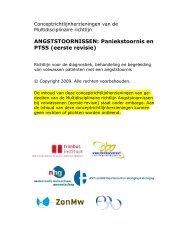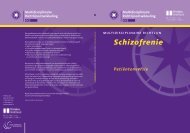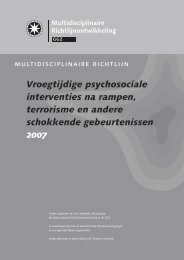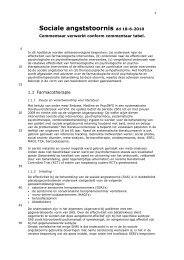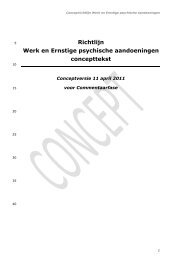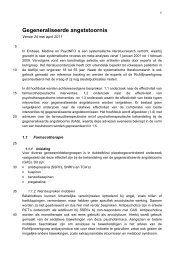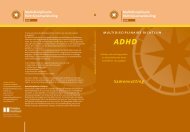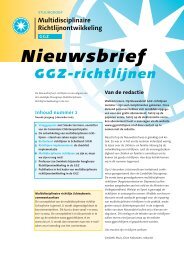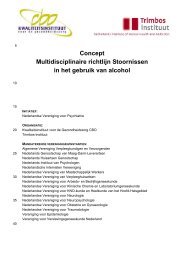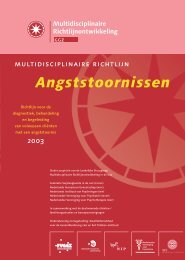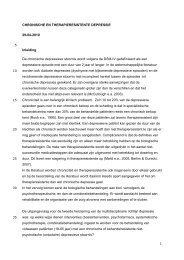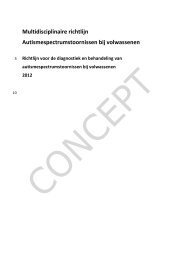Concept Multidisciplinaire richtlijn Stoornissen in ... - GGZ-richtlijnen
Concept Multidisciplinaire richtlijn Stoornissen in ... - GGZ-richtlijnen
Concept Multidisciplinaire richtlijn Stoornissen in ... - GGZ-richtlijnen
Create successful ePaper yourself
Turn your PDF publications into a flip-book with our unique Google optimized e-Paper software.
5<br />
10<br />
15<br />
20<br />
25<br />
30<br />
35<br />
40<br />
45<br />
50<br />
Organisatie van zorg<br />
Uit wat er <strong>in</strong>middels bekend is over de mate waar<strong>in</strong> comorbiditeit voorkomt en over de noodzaak<br />
beide stoornissen <strong>in</strong>tegraal te behandelen blijkt de noodzaak eens te meer om verslav<strong>in</strong>gsbehandel<strong>in</strong>g<br />
mogelijk te maken b<strong>in</strong>nen <strong>GGZ</strong> <strong>in</strong>stell<strong>in</strong>gen en behandel<strong>in</strong>g van overige<br />
ziektebeelden b<strong>in</strong>nen de verslav<strong>in</strong>gszorg. Dit is helaas geen nieuw gegeven, een dergelijke<br />
noodzaak wordt <strong>in</strong> Nederland al m<strong>in</strong>stens 20 jaar gevoeld, maar de scheid<strong>in</strong>g tussen beide<br />
werkvelden blijft hardnekkig. Wel zijn er <strong>in</strong>tussen <strong>in</strong> Nederland vele ambulante teams aan het<br />
werk die laagdrempelig en outreachend patiënten met zowel alcoholproblemen als andere<br />
psychiatrische problematiek proberen te benaderen en te behandelen. Het probleem van de<br />
kl<strong>in</strong>ische zorg wordt de afgelopen jaren <strong>in</strong> toenemende mate opgelost door het <strong>in</strong>richten van<br />
gespecialiseerde “Dubbel Diagnose” projecten.<br />
Over de beste manier om deze problematiek op te lossen is het laatste woord nog niet gesproken.<br />
Helaas is er slechts we<strong>in</strong>ig wetenschappelijke kennis beschikbaar die ons ten aanzien<br />
van dit punt zou kunnen leiden.<br />
Literatuur<br />
• Bowen, R., D'Arcy C., Keegan,D., en Senthise van,A., 2000 A controlled trial of cognitive behavioral<br />
treatment of panic <strong>in</strong> alcoholic <strong>in</strong>patiënts with comorbid panic disorder. Addictive behaviors, 25 (4): p.<br />
593-597.<br />
• Berlant J, van Kammen: Open-label topiramate as primary or adjunctive therapy <strong>in</strong> chronic civilian posttraumatic<br />
stress disorder: a prelim<strong>in</strong>ary report. J. Cl<strong>in</strong> Psychiatry, 2002 jan; 63 [1]: 15-20<br />
• British Association for Psychopharmacology, (2004). A. R. L<strong>in</strong>gford-Hughes, S. Welch, and D. J. Nutt,<br />
Evidence-Based Guidel<strong>in</strong>es for the Pharmacological Management of Substance Misuse, Addiction and<br />
Comorbidity: Recommendations from the British Association for Psychopharmacology, Journal of Psychopharmacology,<br />
293-335, Vol. 18 (3), September 2004<br />
• Brown E.S e.a. Switch<strong>in</strong>g outpatients with bipolair or schizo-affective disorder and substance misuse<br />
from their current antipsychotic to aripiprazole. J. Cl<strong>in</strong> Psychiatry,2005, 66, 756-760.<br />
• Brown. R., Evans, D., Miller, I., Burgess E., and Mueller, T., 1997. Cognitive Behavioral treatment for<br />
depression <strong>in</strong> alcoholism. Journal of Consult<strong>in</strong>g and Cl<strong>in</strong>ical Psychology;65 (5): p. 715-726.<br />
• Coffey SF, Stasiewicz PR, Hughes PM, Brimo ML: Trauma-focused imag<strong>in</strong>al exposure for <strong>in</strong>dividuals<br />
with comorbid posttraumatic stress disorder and alcohol dependence:reveal<strong>in</strong>g mechanisms of alcohol<br />
crav<strong>in</strong>g <strong>in</strong> a cue reactivity paradigm. Psychol Addict Behav.2006 Dec;20(4):425-35<br />
• Fawcett J, Kravitz HM, McGuire M, Easton M, Ross J, Pisani V, Fogg LF, Clark D, Whitney M, Kravitz G,<br />
Javaid J, Teas G. 2000. Pharmacological Treatments for Alcoholism: Revisit<strong>in</strong>g Lithium and Consider<strong>in</strong>g<br />
Buspirone. Alcoholism: Cl<strong>in</strong>ical and Experimental Research, 24 (5), 666-674<br />
• Frye MA and Salloum IM 2006 : Bipolar disorder and comorbid alcoholism: prevalence rate and treatment<br />
considerations. Bipolar disorders :8, 677-685<br />
• Geller B, Cooper T, Sun K, Zimerman B, Frazier J, Williams M, Heath J. 1998. Double-Bl<strong>in</strong>d and Placebo-Controlles<br />
Study of Lithium for Adolescent Bipolar Disorders With Secondary Substance Dependency.<br />
J. Am. Acad. Child Adolesc. Psychiatry, 37 (2), 171-178<br />
• Gl<strong>in</strong>d, G vd, S Kooij, D v Du<strong>in</strong>, A Goossensen en P J Carpentier. 2004 Protocol ADHD bij verslav<strong>in</strong>g.<br />
Screen<strong>in</strong>g, diagnostiek en behandel<strong>in</strong>g voor de ambulante en kl<strong>in</strong>ische verslav<strong>in</strong>gszorg.<br />
Utrecht,Trimbos-<strong>in</strong>stituut<br />
• Goldberg JF, Garna JL, Leon AC, Kocsis JH, Portera L. 1999. A history of Substance Abuse Complicates<br />
Remission From Acute Mania <strong>in</strong> Bipolar Disorder. J. Cl<strong>in</strong> Psychiatry, 60(11), 733-740<br />
• Graeber D.A. e.a. A pilotstudy compar<strong>in</strong>g motivational <strong>in</strong>terview<strong>in</strong>g and an educational <strong>in</strong>terview with patients<br />
with schizophrenia and alcohol use disorders. Comm Mental Health Journal, 2003, pp 189-202.<br />
• Hesse M. 2004. Achiev<strong>in</strong>g Abst<strong>in</strong>ence by treat<strong>in</strong>g depression <strong>in</strong> the presence of substance-use disorders.<br />
Addictive Behaviors, 29, 1137-1141.<br />
116 <strong>Concept</strong> multidiscipl<strong>in</strong>iare <strong>richtlijn</strong> stoornissen <strong>in</strong> het gebruik van alcohol, 2007



